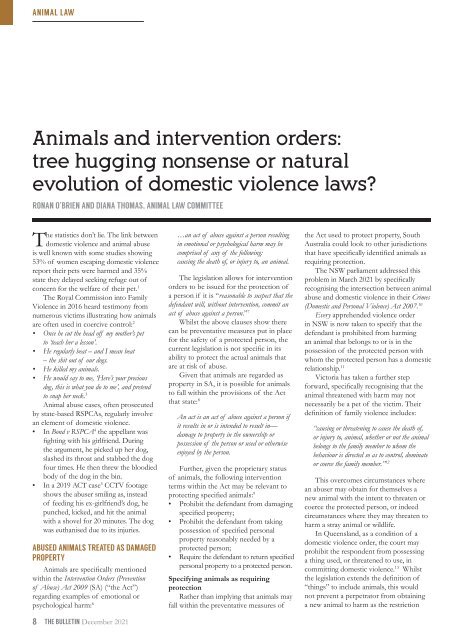LSB December 2021 HR
Create successful ePaper yourself
Turn your PDF publications into a flip-book with our unique Google optimized e-Paper software.
ANIMAL LAW<br />
Animals and intervention orders:<br />
tree hugging nonsense or natural<br />
evolution of domestic violence laws?<br />
RONAN O’BRIEN AND DIANA THOMAS, ANIMAL LAW COMMITTEE<br />
The statistics don’t lie. The link between<br />
domestic violence and animal abuse<br />
is well known with some studies showing<br />
53% of women escaping domestic violence<br />
report their pets were harmed and 35%<br />
state they delayed seeking refuge out of<br />
concern for the welfare of their pet. 1<br />
The Royal Commission into Family<br />
Violence in 2016 heard testimony from<br />
numerous victims illustrating how animals<br />
are often used in coercive control: 2<br />
• Once he cut the head off my mother’s pet<br />
to ‘teach her a lesson’.<br />
• He regularly beat – and I mean beat<br />
– the shit out of our dogs.<br />
• He killed my animals.<br />
• He would say to me, ‘Here’s your precious<br />
dog, this is what you do to me’, and pretend<br />
to snap her neck. 3<br />
Animal abuse cases, often prosecuted<br />
by state-based RSPCAs, regularly involve<br />
an element of domestic violence.<br />
• In Bond v RSPCA 4 the appellant was<br />
fighting with his girlfriend. During<br />
the argument, he picked up her dog,<br />
slashed its throat and stabbed the dog<br />
four times. He then threw the bloodied<br />
body of the dog in the bin.<br />
• In a 2019 ACT case 5 CCTV footage<br />
shows the abuser smiling as, instead<br />
of feeding his ex-girlfriend’s dog, he<br />
punched, kicked, and hit the animal<br />
with a shovel for 20 minutes. The dog<br />
was euthanised due to its injuries.<br />
ABUSED ANIMALS TREATED AS DAMAGED<br />
PROPERTY<br />
Animals are specifically mentioned<br />
within the Intervention Orders (Prevention<br />
of Abuse) Act 2009 (SA) (“the Act”)<br />
regarding examples of emotional or<br />
psychological harm: 6<br />
…an act of abuse against a person resulting<br />
in emotional or psychological harm may be<br />
comprised of any of the following:<br />
causing the death of, or injury to, an animal.<br />
The legislation allows for intervention<br />
orders to be issued for the protection of<br />
a person if it is “reasonable to suspect that the<br />
defendant will, without intervention, commit an<br />
act of abuse against a person.” 7<br />
Whilst the above clauses show there<br />
can be preventative measures put in place<br />
for the safety of a protected person, the<br />
current legislation is not specific in its<br />
ability to protect the actual animals that<br />
are at risk of abuse.<br />
Given that animals are regarded as<br />
property in SA, it is possible for animals<br />
to fall within the provisions of the Act<br />
that state: 8<br />
An act is an act of abuse against a person if<br />
it results in or is intended to result in—<br />
damage to property in the ownership or<br />
possession of the person or used or otherwise<br />
enjoyed by the person.<br />
Further, given the proprietary status<br />
of animals, the following intervention<br />
terms within the Act may be relevant to<br />
protecting specified animals: 9<br />
• Prohibit the defendant from damaging<br />
specified property;<br />
• Prohibit the defendant from taking<br />
possession of specified personal<br />
property reasonably needed by a<br />
protected person;<br />
• Require the defendant to return specified<br />
personal property to a protected person.<br />
Specifying animals as requiring<br />
protection<br />
Rather than implying that animals may<br />
fall within the preventative measures of<br />
the Act used to protect property, South<br />
Australia could look to other jurisdictions<br />
that have specifically identified animals as<br />
requiring protection.<br />
The NSW parliament addressed this<br />
problem in March <strong>2021</strong> by specifically<br />
recognising the intersection between animal<br />
abuse and domestic violence in their Crimes<br />
(Domestic and Personal Violence) Act 2007. 10<br />
Every apprehended violence order<br />
in NSW is now taken to specify that the<br />
defendant is prohibited from harming<br />
an animal that belongs to or is in the<br />
possession of the protected person with<br />
whom the protected person has a domestic<br />
relationship. 11<br />
Victoria has taken a further step<br />
forward, specifically recognising that the<br />
animal threatened with harm may not<br />
necessarily be a pet of the victim. Their<br />
definition of family violence includes:<br />
“causing or threatening to cause the death of,<br />
or injury to, animal, whether or not the animal<br />
belongs to the family member to whom the<br />
behaviour is directed so as to control, dominate<br />
or coerce the family member.” 12<br />
This overcomes circumstances where<br />
an abuser may obtain for themselves a<br />
new animal with the intent to threaten or<br />
coerce the protected person, or indeed<br />
circumstances where they may threaten to<br />
harm a stray animal or wildlife.<br />
In Queensland, as a condition of a<br />
domestic violence order, the court may<br />
prohibit the respondent from possessing<br />
a thing used, or threatened to use, in<br />
committing domestic violence. 13 Whilst<br />
the legislation extends the definition of<br />
“things” to include animals, this would<br />
not prevent a perpetrator from obtaining<br />
a new animal to harm as the restriction<br />
8<br />
THE BULLETIN <strong>December</strong> <strong>2021</strong>


















